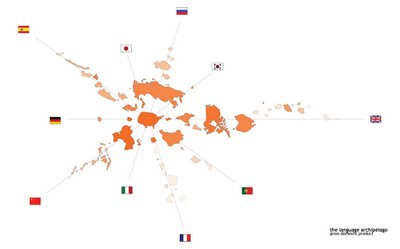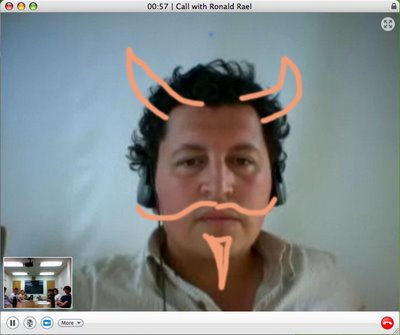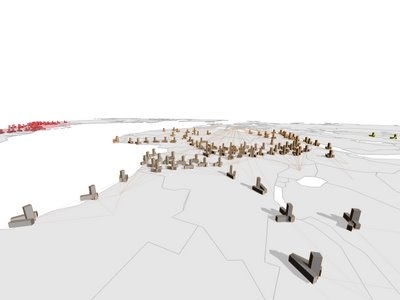below, the project is presented in two parts. the first part focuses on the creation of a global map of the internet and the second elaborates on the proposed internet archipelago.
1.0 global mapimation
in his essay entitled the agency of mapping, james corner outlines several techniques for mapping that goes beyond a literal tracing of a condition to discover its latent potential. although this essay served as a point of departure for this project, its techniques had to be reconsidered and adapted to a new medium: an animated three-dimensional map, or mapimation.a mapimation of the internet was created, filtered through the lens of language (and, to a lesser extent, internet infrastructure). it was spurred by a disappointing statistic on web content that revealed the dominance of ten languages on the internet. english accounted for nearly 2/3 of internet content; english together with nine other languages (in order: japanese, german, chinese, french, spanish, russian, italian, portuguese, korean) account for over 95% of internet content. accordingly, countless languages are underrepresented and countless people are restricted or completely prohibited from access to information on the internet.
this mapping is limited to countries are home to a significant population speaking an internet language (a significant population is defined as at least 100,000 first tongue speakers). the political map of the world is rearranged based on internet language populations to create the language archipelago.

img_1.1 the language archipelago / ascendancy
the united states is placed at the center of the language archipelago for several reasons. it is the only country that has a significant population speaking all ten internet languages. it has the most extensive internet infrastructure. and it was the birthplace of the internet. from there, all the other internet countries are arranged in rays corresponding to the countries’ dominant internet language based on their ascendancy. the national flag at the end of each ray is used as a visual legend to key the ray’s language. this map illustrates the dominant role of the world’s superpowers on in internet and reveal the circumstance of countries at the periphery.

img_1.2 the language archipelago / continuum
in this map, all the countries are woven together by a language continuum. this map illustrates the complex web of language that exists in the world and the potential of the internet to provide a common ground for these languages.

img_1.3 the language archipelago / perspective
each country is also placed in 3d space based upon its internet infrastructure. the internet is of course a physical network bound by infrastructure. the height of a country in the language archipelago is inversely related to the number of ip address per capita allocated to that country. (the number of ip address controls the number of devices that can simultaneously access the internet). the united states is allocated roughly 2 ip addresses per person and is placed to the bottom of the language archipelago. niger, which is allocated a total of 256 ip addresses, is placed at the top of the language archipelago.

anim_1.4 the language archipelago / mapimation
here, the known political world is morphed into the language archipelago. the lines of continuum are then constructed.

img_1.5 gdp of the language archipelago
here, the concentration of gross domestic product is clearly at the center of the archipelago. because the internet is so closely tied to its infrastructure, it stands to reason that wealthier countries have more internet .

img_1.6 aids in the language archipelago
notice that there is a tendency for aids to me more prevalent at the periphery of the archipelago. aids and other socioeconomic struggles seem to be inversely related to gdp and inversely related to the internet. it seems possible that the spread of the internet to and within these nations could provide the information and knowledge to begin to alleviate these problems and bring about change.
2.0 global network archipelago
in the second phase of the project, an architectural response was made to the language archipelago. this mapping revealed certain inequities that existed on the internet and within its infrastructure. there is the potential for the internet to facilitate the exchange of ideas and information at a truly global scale, and this project seeks to promote this through the creation of internet archipelagos.
img_2.1 the logic of the internet archipelago
each of these archipelagos is made up of a series of installations, connected to one another by antenna arrays carried by hot-air balloons. as such, the archipelagos are able to cover vast territories without depending on the existing infrastructure.
the installation is comprised of three volumes, each of which responds to a particular condition unique to the location of the installation and houses functions specific to this condition:
* the internet
* language
* local need (such as aids relief, disaster relief, etc.)
each of these volumes also serves to map the condition to which it responds. it orients itself towards the condition and derives its size from the weight of the condition. as the condition changes, so too does the installation. to determine the form of the installation, an algorithm calculates the relationship between the installation and each condition at various moments in time, and generates form accordingly. to accomplish this, the conditions are mapped and their tendencies for change animated. (see the final algorithm)

img_2.2 a single animation

anim_2.3 a single animation, morphing

anim_2.4 an internet archipelago

anim_2.5 a single installation, dynamically changing in a static world

anim_2.6 a single installation, morphing
this project walks the line between the real and the virtual. its function is closely tied to the real world and the current state of the internet and ambitiously seeks to change it. its form, however, is much more grounded in the virtual world. it seeks to explore the possibility of architecture to continuously respond to dynamic conditions and in fact affect these conditions through its change. an example of this potential: the local needs volume moves and grows as the aids epidmic spreads toward it. this physical growth informs its users, who can respond to this spread and stem its progress. these actions are then reflected in the form of the installation.














